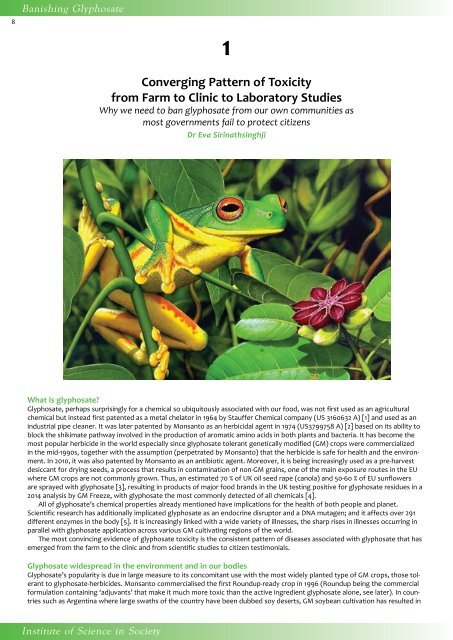Banishing Glyphosate
BanishingGlyphosate
BanishingGlyphosate
You also want an ePaper? Increase the reach of your titles
YUMPU automatically turns print PDFs into web optimized ePapers that Google loves.
8<br />
<strong>Banishing</strong> <strong>Glyphosate</strong><br />
1<br />
Converging Pattern of Toxicity<br />
from Farm to Clinic to Laboratory Studies<br />
Why we need to ban glyphosate from our own communities as<br />
most governments fail to protect citizens<br />
Dr Eva Sirinathsinghji<br />
What is glyphosate?<br />
<strong>Glyphosate</strong>, perhaps surprisingly for a chemical so ubiquitously associated with our food, was not first used as an agricultural<br />
chemical but instead first patented as a metal chelator in 1964 by Stauffer Chemical company (US 3160632 A) [1] and used as an<br />
industrial pipe cleaner. It was later patented by Monsanto as an herbicidal agent in 1974 (US3799758 A) [2] based on its ability to<br />
block the shikimate pathway involved in the production of aromatic amino acids in both plants and bacteria. It has become the<br />
most popular herbicide in the world especially since glyphosate tolerant genetically modified (GM) crops were commercialized<br />
in the mid-1990s, together with the assumption (perpetrated by Monsanto) that the herbicide is safe for health and the environment.<br />
In 2010, it was also patented by Monsanto as an antibiotic agent. Moreover, it is being increasingly used as a pre-harvest<br />
desiccant for drying seeds, a process that results in contamination of non-GM grains, one of the main exposure routes in the EU<br />
where GM crops are not commonly grown. Thus, an estimated 70 % of UK oil seed rape (canola) and 50-60 % of EU sunflowers<br />
are sprayed with glyphosate [3], resulting in products of major food brands in the UK testing positive for glyphosate residues in a<br />
2014 analysis by GM Freeze, with glyphosate the most commonly detected of all chemicals [4].<br />
All of glyphosate’s chemical properties already mentioned have implications for the health of both people and planet.<br />
Scientific research has additionally implicated glyphosate as an endocrine disruptor and a DNA mutagen; and it affects over 291<br />
different enzymes in the body [5]. It is increasingly linked with a wide variety of illnesses, the sharp rises in illnesses occurring in<br />
parallel with glyphosate application across various GM cultivating regions of the world.<br />
The most convincing evidence of glyphosate toxicity is the consistent pattern of diseases associated with glyphosate that has<br />
emerged from the farm to the clinic and from scientific studies to citizen testimonials.<br />
<strong>Glyphosate</strong> widespread in the environment and in our bodies<br />
<strong>Glyphosate</strong>’s popularity is due in large measure to its concomitant use with the most widely planted type of GM crops, those tolerant<br />
to glyphosate-herbicides. Monsanto commercialised the first Roundup-ready crop in 1996 (Roundup being the commercial<br />
formulation containing ‘adjuvants’ that make it much more toxic than the active ingredient glyphosate alone, see later). In countries<br />
such as Argentina where large swaths of the country have been dubbed soy deserts, GM soybean cultivation has resulted in<br />
Institute of Science in Society


